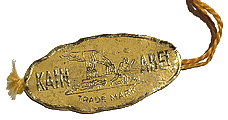Emil Broch and his twin sister Selma were born on October 25, 1872 in Schaafenmühle in Höhscheid*. They were the last two of the five children of Karl Gottfried Friedrich Broch and Johanna Karolina Broch (born Voos), who had married in 1855.
Friedrich Broch was a blacksmith and a pen knife grinder by profession. In the year 1858, he had acquired the grinding mill in Schaafenmühle on the “Nacker” creek, together with his companion Eduard Lauterjung, after the mill had burned out a year earlier. In the same year, the new owners requested the reconstruction of the “Kotten”.
It is therefore obvious that the blacksmith’s craft was layed into Emil’s cradle, as was the case with many Solingen families. This also applies to his elder brother Hugo (born on February 24, 1863), who was also a professional grinder. Hugo and Emil Broch later took over the grinding mill in Schaafenmühle, after the death of their father. As it turned out, they became it’s last owners.
Emil Broch’s brother Hugo
Since 1891, a drop forging factory named “Hugo Broch” existed on Katternberger Street. Although Emil’s brother was also involved in the forging trade, my presumption did not confirm that he was the owner of this company. (At that time there were two other persons named Hugo Broch in the Solingen district, and both were listed as manufacturers.) Hugo married Emma Hoppe in the year 1888, with whom he had two children. According to the civic book of Merscheid (issue 1885-1895), Emma and Hugo moved into the house on the address “Hübben 17” with their first-born daughter in the year 1890.
At this address, Emil Broch’s brother is still listed 68 years old in the Solingen address book of 1931. In the meantime, Emil – together with his wife Martha and their son Fritz Willi (“Willy”) – had also moved into the house, which also served as the first company seat of the Emil Broch razor factory. Whether Hugo Broch has ever been involved in his brother’s razor production is uncertain as of yet. However, the Schaafenmühle “Kotten” was unlikely to have been used in the production. Because after the mill had burned down and was rebuilt for the second time in 1908, the brothers sold it to the city of Solingen in 1915. (Previously, however, the “Kotten” very probably played an important role for the straight razors of Broch & Woop.) In the 1920s, together with further “Kotten” and mills on the Nacker creek, it was shut down in the course of construction of a sewage treatment plant, about one kilometre upstream.
(On the aerial photograph of 1928 shown here, there is a building that I believe must be the Kotten, but this building is no longer visible on the 1929 map of the city. Even to this date, on the place where it stood, the lettering “Schaafenmühler Kotten” can still be found in the geospatial portal of the city of Solingen. On that website, you can also access the old city map and the aerial view mentioned above.)
Emil’s other siblings were Hulda (1864-1917) and Friedrich Wilhelm, who died in 1871 – one year after his birth – to diphtheria. Presumably, Emil honored his brother by giving his own son the name Fritz Willi in 1904 – who later always called himself Willy, with a Y.
* Until the city association of 1929, the municipality of Höhscheid – as well as the municipalities of Wald, Gräfrath and Ohligs – was independent. On August 1, 1929, they were then merged with the town of Solingen into a city.
The houses Schaafenmühle 3 and 5 belonged to the Broch family, Emil’s home was on number 3 – the house still exists today, but probably under the number 21. I couldn’t yet find out when the city of Solingen changed the house numbers on Schaafenmühle.
The Family Tree (click to enlarge)


